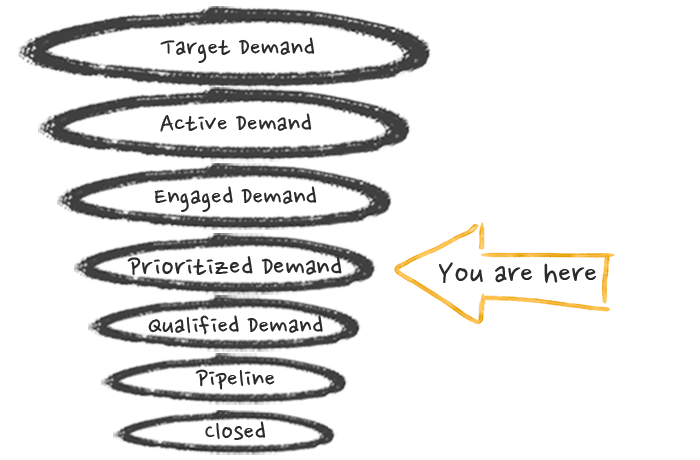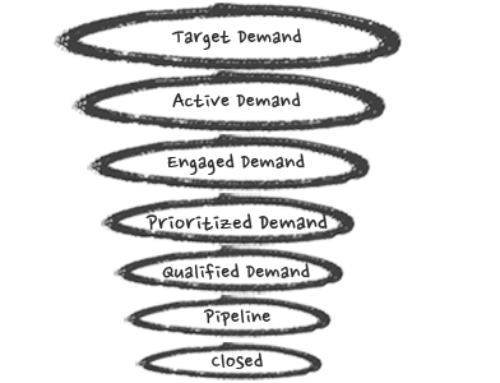
The principal objective in the Prioritized Demand stage is to evaluate when an account has reached a threshold of engagement, indicating sufficient buying signals to warrant passing it to the sales team.
This is the rough equivalent to creating a marketing-qualified lead (MQL) through lead scoring but expanded from a lead to an entire account.
I find that this stage can be a little confusing when compared with the Engaged Demand stage. From a pragmatic perspective, I see the prior Engaged Demand stage and this Prioritized Demand stage as interactions and measurement. Engaged Demand is where all your marketing interactions with prospects happen and Prioritized Demand is where you measure those to determine whether the account is ready to be handed over to sales.
Stumbling blocks
Getting the threshold account score optimized for sending prospect accounts to sales. Since you typically won’t know what the ideal threshold account score is for your prospects, you will need to test. My approach has been to first send accounts over with a low bar and let sales know that I am doing that. I ask salespeople to rate each account and offer feedback on what they hear when/if they talk to prospects. With that feedback, I am able to work hand-in-hand with sales on setting the threshold to optimize for the quality of accounts they are receiving.
There are lots of variables to consider here beyond just raw account score. For example, do you need to keep the account in the Engaged Demand stage until at least two prospects from a company have a score? Is there a specific action or set of steps that a prospect must take to qualify them?
In the same way this is done for lead scoring, you need to set up a score for each activity. For example, is attending a webinar worth 2x, 5x or 10x the score as a visit to your home page? What about your product information pages? An online chat where the prospect has questions? Is there one thing that a prospect might do that would automatically send them to the next level such as reviewing your pricing pages?
Evaluating, testing and optimizing account scores. Once you have set up the baseline account scores for each activity and the rules for account thresholds, how do you know you have done it correctly? Only through evaluating what happens in the next stage and then testing and optimizing in this stage are you going to know.
Preparing for success
Account scoring. With account-based marketing (ABM) gaining wider adoption, marketers are looking for ways to go beyond lead scoring to account scoring. Your objective in using the Demand Unit Waterfall is to influence the entire Demand Unit, so what you need is a way to aggregate all the behavior from an account, not just a single contact.
I would imagine that the marketing and sales automation vendors are seeing this demand from their customers and are working towards ways of aggregating leads and website visitors into account scores. At the time of this writing, I am aware of no major marketing or sales automation tools that make account-level scoring easy or out of the box.
There are, however, products specifically designed to address the need for account scoring. I have used Engagio for my account scoring needs. Engagio connects to your sales automation/CRM tools, in addition to placing a tracking script on your web properties so that it can track and score the aggregate of activities across an account. Engagio uses a tracking metric that it calls: “account minutes.” I find that more intuitive than a point score, but functionally it is the same as lead scoring with the marketing team assigning account minutes (as opposed to lead scores) to different activities.
Account scoring is done even when much or all of the account consists of anonymous browsing activity. When any one of the visitors completes a form identifying themselves, all historical activity for those visitors gets mapped to them, so you can see the details of what each person has consumed as well as the aggregate of actions from all visitors (anonymous and not) from the account.
In some cases, you may have some very active accounts but never get a form completion from them. In those cases, I go ahead and push the account down the next stage, Qualified Demand, so the sales team can start working the account to figure out who in that account is interested in my product or service.
Lead vs. account scoring

Lead and account scoring are very similar, but lead scoring addresses the aggregate of activities for an individual while the account scoring does that for an account.
- Visitors interact with your company, downloading documents, browsing web pages, attending webinars.
- Each of those activities has an associated lead score which is typically set in the marketing automation system.
- The aggregate score of the activities is tallied into a lead score.
- Visitors from the same company interact with your company, downloading documents, browsing web pages, attending webinars.
- Each of those activities has an associated lead score which is typically set in the marketing automation system.
- The aggregate score of the activities is tallied into an account score.
Team makeup
In this stage, you are working with the marketing operations team to make sure all behavioral tracking is working correctly. You are also working with your analytics group to evaluate buyer behavior, so you can set up your account scoring system and implement a testing and optimization program.
Deliverables
Activity scoring set up in your systems along with plans to test and optimize against accounts that convert to the next stage: Qualified Demand. Since optimizing to that provides a quantity of accounts moving to the next stage, not the quality of those accounts, you will also need to evaluate closed-won accounts to see what those account behaviors and collateral consumption were. That will help you tighten your buyer journey and scoring rules.
Account progression in-depth
This is an exercise of quantity vs. quality. If you send accounts to sales too soon, you are eating up valuable sales resources with little return. In the best case, sales will tell you that the accounts are worthless, in the worst case, they will not work them at all. I provide more detail on account progression logic in the Demand Unit Waterfall post.
Measuring success for Prioritized Demand
The principal KPI to track is the number of accounts that meet or exceed the engagement score you have set before handing those accounts over to sales.
Metrics you will want to measure to help optimize for this outcome include:
- Performance of your collateral/assets. Ideally, you would track how each asset is doing as well as which assets tend to get associated with accounts that make it to the next level in the funnel. If you have enough sales volume, you should also measure which assets were most commonly consumed by those that became customers.
- Percentage of accounts that interact. If the percentage is lower than about 80%, consider moving those accounts back up the funnel to the Active Demand stage to nurture longer and setting the threshold for moving accounts from Active Demand to Engaged Demand higher.



